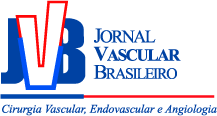Tratamento endovascular da doença obstrutiva carotídea em pacientes de alto risco: resultados imediatos
Endovascular treatment of carotid obstructive disease in high risk patients: immediate results
Ricardo Augusto Carvalho Lujan; Leonardo Aguiar Lucas; Andréa de Fátima Gracio; Armando de Carvalho Lobato
Resumo
Palavras-chave
Abstract
Keywords
References
Beneficial effect of carotid endarterectomy in symptomatic patients with high-grade stenosis: North American Symptomatic Carotid Endarterectomy Trial Collaborators. N Engl J Med. 1991;325:445-53.
MRC European Carotid Surgery Trial: interim results for symptomatic patients with severe (70-99%) or with mild (0-29%) carotid stenosis European Carotid Surgery Trialists' Collaborative Group. Lancet. 1991;337:1235-43.
Executive Committee for the Asymptomatic Carotid Atherosclerosis Study. JAMA. 1995;273:1421-8.
Wolf PA, D'Agostino RB, Belanger AJ, Kannel WB. Probability of stroke: a risk profile from Framingham Study. Stroke. 1991;22:312-8.
Moore WS, Barnett HJ, Beebe HG. Guidelines for carotid endarterectomy: A multidisciplinary consensus statement from the ad hoc Committee, American Heart Association. Stroke. 1995;26:188-201.
Crouse JR, Toole JF, McKinney WM. Risk factors for extracranial carotid artery atherosclerosis. Stroke. 1987;18:990-6.
O'Leary DH, Anderson KM, Wolf PA, Evans JC, Poehlman HW. Cholesterol and carotid atherosclerosis in older persons: the Framingham Study. Ann Epidemiol. 1992;2:147-53.
Antiplatelet Trialists Collaboration. BMJ. 1994;308:81-106.
Fields WS, Lemak NA, Frankowski RF, Hardy RJ. Controlled trial of aspirin in cerebral ischemia. Stroke. 1977;8:301-14.
Ouriel K, Hertzer NR, Beven EG. Preprocedural risk stratification: identifying an appropriate population for carotid stenting. J Vasc Surg. 2001;33:728-32.
Hobson RW, Weiss DG, Fields WS. Efficacy of carotid endarterectomy for asymptomatic carotid stenosis. The Veterans Affairs Cooperative Study Group N Engl J Med. 1993;328:221-7.
Veith FJ, Amor M, Ohki T. Current status of carotid bifurcation angioplasty and stenting based on a consensus of opinion leaders. J Vasc Surg. 2001;33(^s2):S111-6.
Wennberg DE, Lucas FL, Birkmeyer JD, Bredenberg CE, Fisher ES. Variation in carotid endarterectomy mortality in the Medicare population: trial hospitals, volume, and patient characteristics. JAMA. 1998;279:1278-81.
Tardini DM, Yoshida WB. Brain injury due to ischemia and reperfusion in carotid endarterectomy surgery. Rev Port Cir Cardiotorac Vasc. 2003;10:133-40.
Diethrich EB. Indications for carotid artery stenting: a preview of the potential derived from early clinical experience. J Endovasc Surg. 1996;3:132-9.
Ouriel K, Yadav J, Green RM. Standards of practice: carotid angioplasty and stenting. J Vasc Surg. 2004;39:916-7.
Wholey MH, Wholey M, Mathias K. Global experience in cervical carotid artery stent placement. Catheter Cardiovasc Interv. 2000;50:160-7.
Yadav JS, Wholey MH, Kuntz RE. Protected carotid-artery stenting versus endarterectomy in high risk patients. N Engl J Med. 2004;351:1493-501.
Illig KA, Zhang R, Tanski W, Benesch C, Sternbach Y, Green RM. Is the rationale for carotid angioplasty and stenting in patients excluded from NASCET/ACAS or eligible for ARCHeR justified?. J Vasc Surg. 2003;37:575-81.
Jordan WD Jr., Alcocer F, Wirthlin DJ. High-risk carotid endarterectomy: challenges for carotid stent protocols. J Vasc Surg. 2002;35:16-21.
Mozes G, Sullivan TM, Torres-Russotto DR. Carotid endarterectomy in SAPPHIRE-eligible high-risk patients: implications for selecting patients for carotid angioplasty and stenting. J Vasc Surg. 2004;39:958-65.
New G, Roubin GS, Iyer SS. Safety, efficacy, and durability of carotid artery stenting for restenosis following carotid endarterectomy: a multicenter study. J Endovasc Ther. 2000:345-52.
Hobson RW, Goldstein JE, Jamil Z. Carotid restenosis: operative and endovascular management. J Vasc Surg. 1999;29:228-35.
Henry M, Amor M, Masson I. Angioplasty and stenting of the extracranial carotid arteries. J Endovasc Surg.. 1998;5:293-304.
Merlo M, Conforti M, Apostolou D, Carignano G. Surgical and endovascular treatment of stenosis of the innominate artery. Minerva Cardioangiol. 1999;47:49-54.
Sullivan TM, Gray BH, Bacharach JM. Angioplasty and primary stenting of the subclavian, innominate, and common carotid arteries in 83 patients. J Vasc Surg. 1998;28:1059-65.
Order BM, Gass C, Liess C, Heller M, Muller-Hulsbeck S. Comparison of 4 cerebral protection filters for carotid angioplasty: an in vitro experiment focusing on carotid anatomy. J Endovasc Ther. 2004;11:211-8.
Rapp JH, Pan XM, Sharp FR. Atheroemboli to the brain: size threshold for causing acute neuronal cell death. J Vasc Surg. 2000;32:68-76.
Ohki T, Marin ML, Lyon RT. Ex vivo human carotid artery bifurcation stenting: correlation of lesion characteristics with embolic potential. J Vasc Surg. 1998;27:463-71.
Reimers B, Corvaja N, Moshiri S. Cerebral protection with filter devices during carotid artery stenting. Circulation. 2001;104:12-5.
Jordan WD Jr, Voellinger DC, Doblar DD, Plyushcheva NP, Fisher WS, McDowell HA. Microemboli detect by transcranial Doppler monitoring in patients during carotid angioplasty versus carotid endarterectomy. Cardiovasc Surg. 1999;7:33-8.
Endovascular versus surgical treatment in patients with carotid stenosis in the Carotid and Vertebral Artery Transluminal Angioplasty Study (CAVATAS): a randomized study. Lancet. 2001;357:1729-37.
Cremonesi A, Manetti R, Setacci F, Setacci C, Castriota F. Protected carotid stenting: clinical advantages and complications of embolic protection devices in 442 consecutive patients. Stroke. 2003;34:1936-41.
Castriota F, Cremonesi A, Manetti R. Impact of cerebral protection devices on early outcome of carotid stenting. J Endovasc Ther. 2002;9:786-92.
Diethrich EB, Ndiaye M, Reid DB. Stenting in the carotid artery: initial experience in 110 patients. J Vasc Surg. 1996;3:42-62.

